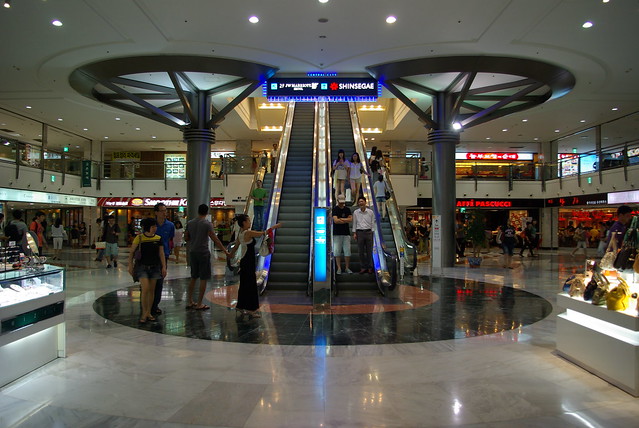In a nutshell, I think the public transport is pretty amazing. Compared to transport in England and America, for me it wins, no questions asked. Although I appreciate that if you’re elderly, best take a car…
 |
| T-money charms |
 |
| Scanning the T-money charm |
 Aesthetically…the subway is naturally a lot more modern than anything in London or France, but it also actually kept clean. Everything is a shade of white or chrome with adverts, shops and subway maps adding a splash of colour. One nice auditory feature that the subway has is that when your train is about to arrive at your platform, a little stereotypically Asian chime will play out of the speakers, and is followed by an announcement telling you where the train is going, and what the next stop is, just incase you missed the signs everywhere which tell you which way the train is going and what the next stop is.
Aesthetically…the subway is naturally a lot more modern than anything in London or France, but it also actually kept clean. Everything is a shade of white or chrome with adverts, shops and subway maps adding a splash of colour. One nice auditory feature that the subway has is that when your train is about to arrive at your platform, a little stereotypically Asian chime will play out of the speakers, and is followed by an announcement telling you where the train is going, and what the next stop is, just incase you missed the signs everywhere which tell you which way the train is going and what the next stop is. For convenience as well, there are a lot of shops in the Subway, In Seoul there are many underground malls that I’ve just stumbled into when not paying attention. Although, these are usually selling stuff that old women would buy. And Finally, there is copious amounts of free wifi, as to be expected with Korea.
Moving onto Inter city transport with coaches. I haven’t had the pleasure of travelling by train yet in Korea, and it may not happen while I’m here, but I can at least tell you about the Coach system. Much like the Korean subway, with the large inter city coach stations, there is information everywhere in several languages, and all the large ones that I’ve been to are attached to an extensive shopping mall. In the same way that you pay a single flat rate on the subway, you do the same for an intercity coach. However for these you must go and buy a ticket. These buses are usually express anyway, but between some cities there is maybe one or two stops, and the price doesn’t change weather you get off at those or the final destination. Price wise I’d pay maybe £5-£7 each way depending on which cities I’m travelling to and from. Again, dirt cheap.

 But these coaches aren’t like your national express coaches, or Grayhound or Trailways. Oh no, the Koreans like to travel with comfort. Firstly everyone is assigned a seat number, and then the seats are spaced enough so have more than enough leg room. Your seat can recline with a leg rest and your seats are usually heated when it’s cold. Coach etiquette is pretty much, be quiet and keep yourself to yourself. And people do, because most people sleep on these coaches, even if it’s the middle of the day. And kids on these coaches don’t scream and cry either, they just sleep too. The odd person might have a phone call but they’ll cut it short and call back later. And again, these coaches are kept immaculate. There is usually a TV too which is connected to wifi and plays the news (no volume with subtitles in Korean) where I get my weekly update on what's happening in the world.
But these coaches aren’t like your national express coaches, or Grayhound or Trailways. Oh no, the Koreans like to travel with comfort. Firstly everyone is assigned a seat number, and then the seats are spaced enough so have more than enough leg room. Your seat can recline with a leg rest and your seats are usually heated when it’s cold. Coach etiquette is pretty much, be quiet and keep yourself to yourself. And people do, because most people sleep on these coaches, even if it’s the middle of the day. And kids on these coaches don’t scream and cry either, they just sleep too. The odd person might have a phone call but they’ll cut it short and call back later. And again, these coaches are kept immaculate. There is usually a TV too which is connected to wifi and plays the news (no volume with subtitles in Korean) where I get my weekly update on what's happening in the world.Moving onto local and internal city public transport.
From where I live (the middle of nowhere) and regular city public transport, there is very little difference. It’s regular, even where I live, and it’s almost never late. Like with coaches and the subway when you get on you pay a flat rate no matter weather you’re going just one stop or all the way to the terminal, and it usually costs between £1 and £1.25. The main difference however is the difference in how much English is available. In the city bus terminals, there is usually English signs, where I live, there isn't. So If I came to Korea before learning Hangeul, I'd find it mighty hard getting from A to B when looking at this...
 |
| You might not be able to see bit it's all Korean apart from the word "Timetable" |
But yeah that pretty much covers public transport from my experience so far. ^^
















